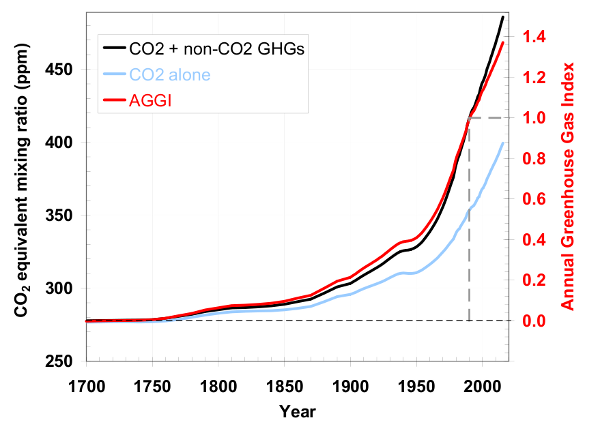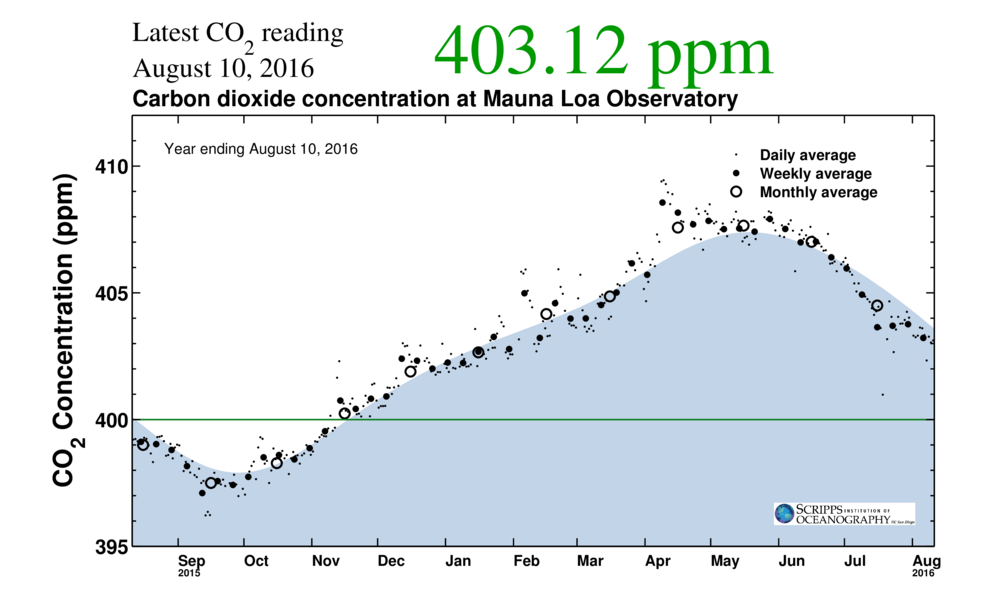Posted: Aug 15, 2016 12:44 pm
CO2e a more encompassing measurement...
more
Smashing Through 490 — Fragmenting Prospects for Avoiding 2 C Warming
“The IPCC indicated in its fourth assessment report that achieving a 2 C target would mean stabilizing greenhouse gas concentrations in the atmosphere at around 445 to 490 ppm CO2 equivalent or lower. Higher levels would substantially increase the risks of harmful and irreversible climate change.” –Johan Eliasch
NOAA's Greenhouse Gas Index
(NOAA’s greenhouse gas index shows that CO2e concentration for 2015 averaged 485 ppm. Given recent rates of rise, the 2016 average should be near 490 ppm CO2e. At the latest, this key threshold will be crossed some time during 2017. Image source: NOAA’s Earth Systems Research Laboratory.)
https://robertscribbler.com/2016/08/12/ ... c-warming/
*****
There are a few things we know about climate change that should really keep us up at night. The first is that the world is warming, and this warming of the Earth, in so many ways, is dangerous to human beings and all the other innocent creatures living here.
The second is that, over recent years, this warming has been very rapid. In the three years from 2014 through 2016, the Earth’s atmospheric temperature is likely to have increased by 0.2 degrees Celsius or more to around 1.2 C above 1880s levels. When thinking about this in absolute terms, it doesn’t sound like much. But in geological terms, this is very rapid warming, especially when you consider that, at the end of the last ice age, it took about 400 years to produce a similar amount of atmospheric temperature gain.
What all this boils down to is that as global temperatures have spiked, we’ve rapidly crossed an established climate threshold into a far more geophysically dangerous time.
Surging Levels of Heat-Trapping Gasses
405 parts per million carbon dioxide. That’s about the average level of CO2 accumulation the Earth’s atmosphere will see by the end of 2016, due primarily to fossil-fuel burning. It’s a big number. The Earth hasn’t seen a number like that in millions of years. But 405 ppm CO2 doesn’t tell the whole story of heat-trapping gasses in the atmosphere. To do that, we have to look at another number — carbon dioxide equivalent or CO2e.
The Keeling Curve August
(During a typical September and October, daily or weekly values may briefly dip below 400 ppm CO2, as detected at the Mauna Loa Observatory. But after September-October 2016, it’s unlikely that you or I will ever see such low levels of CO2 from that measure again in our lifetimes. Image source: Scripps Institution of Oceanography.)
490 ppm CO2e. That’s about the total amount of CO2-equivalent heat forcing from all the human-added greenhouse gasses like CO2, methane, various nitrogen compounds, and other gaseous chemical waste that the Earth’s atmosphere will see by late 2016 to early 2017.
Why is this a big deal?
Four reasons —
First, hitting 490 CO2e crosses the Intergovernmental Panel on Climate Change‘s (IPCC) lowest climate threshold. If this were a highway, and climate change were a collision, we’d now be careening through the first guardrail.
Second, 490 CO2e represents significant current and future warming (and there’s good reason to believe that IPCC’s estimates of that warming may be a bit conservative).
Third, it signifies that we have now fully entered the era of catastrophic climate change, with some bad climate outcomes almost certainly locked in as a result. We see a number of these instances now in the form of extreme rainfall events, extreme drought, coral bleaching, sea ice and glacial melt, threatened crops, ocean anoxia and dead zones, widespread harmful algae blooms, ocean acidification, and expanding infectious disease ranges. However, what we are experiencing now is just the tip of the (melting) climate change iceberg if we do not rapidly respond.
Fourth, if we were never really aware before that we very urgently need to get serious about swiftly cutting fossil-fuel emissions, protecting and regrowing forests, and working to help people to adapt to climate change, then this is our wake-up call.
more

